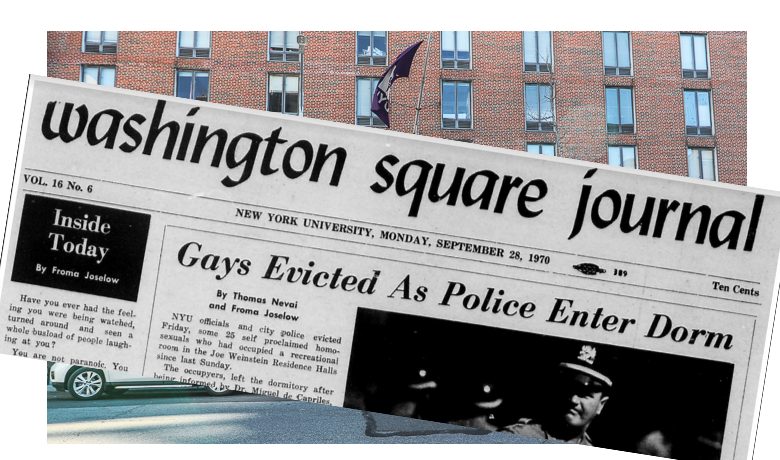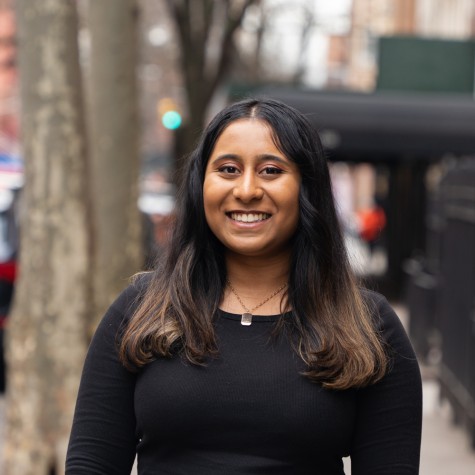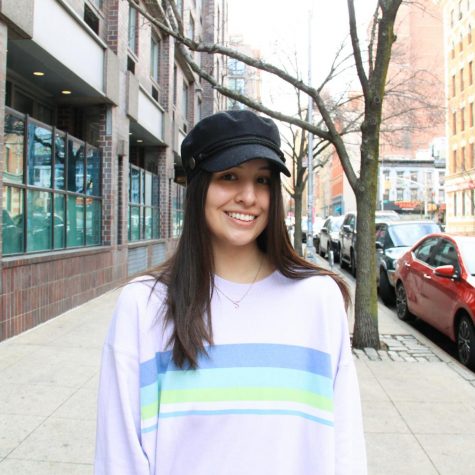Today marks the 50th anniversary of the Weinstein occupation — a five-day sit-in for the LGBTQ+ community at NYU’s Weinstein Residence Hall, starting Sept. 25, 1970. At the time, NYU officials and the Tactical Patrol Force violently removed occupiers. Now, NYU plans to hold a panel on Oct. 24 to discuss the occupation.
The Weinstein occupation took place approximately one year after the June 1969 Stonewall riots, considered by many to be the birthplace of the LGBTQ+ civil rights movement in the United States. The first Pride parades were funded by the Mafia, who did business with gay bars. Looking for alternative funding, members of the Student Gay Liberation Front rented spaces at NYU, such as Weinstein Hall’s recreational centers, and hosted queer dance fundraisers.
LGBTQ+ and NYU history are closely tied to Greenwich Village; the neighborhood is both a hub for the LGBTQ+ community and the home of NYU’s campus. Research suggests about 400 people regularly showed up to the queer dances. Headed by gay rights activists Marsha P. Johnson and Sylvia Rivera, who were behind the Stonewall riots, the sit-ins began when NYU refused to continue providing facilities for meetings and dances. Occupiers told NYU to reinstate the queer dances’ spaces, or they would continue occupying the subcellar.
NYU alumna and U.S. gay rights activist Ellen Broidy participated in the sit-in. Broidy was a chair of NYU’s unofficial chapter of the Student Homophile League. The league was later renamed the NYU Gay Students Liberation.
“I was the person who trotted uptown on a Sunday evening to a meeting of the Gay Liberation Front, at Church of the Holy Apostles on Ninth Avenue, and asked people from Gay Liberation Front, which I was also connected to, to join us and come down and take part in this sit-in in this action against what NYU had done,” Broidy said.
The Washington Square Journal reported on the sit-in and expulsion on Sept. 28, 1970.
“NYU security guards first locked the doors of the room and then opened them to let about 50 TPF (Tactical Patrol Force) cops in helmets with clubs into the room,’” according to a then student — who declined to be identified — interviewed by the Washington Square Journal. “A big guy in a suit shoved the two of us out of the room and said, ‘Get out of here.’”
NYU threatened to expel students and faculty members who occupied Weinstein. Identifiable by name because of her affiliation with the Student Homophile League, Broidy was called into a Dean’s office.
“I was called in and threatened for expulsion,” Broidy said. “They didn’t expel me, but you know [the dean] had the power to be pretty unpleasant … I mean it was clearly an illegal act without the permission of the owners of that space. If we had permission, we wouldn’t have taken over. There was a contract they reneged on.”
The sit-ins had showers, amenities and informal teach-ins for students curious about why mostly non-NYU students were occupying the space. Broidy recalled Weinstein freshmen and sophomores being ecstatic about the occupation.
“All of these freshmen and sophomores in that dorm, who were on payphones in the halls on the upper floors, calling their parents saying, ‘You can’t believe what’s going on,’” Broidy said. “I mean they were just wild. They thought it was the best thing that ever happened in their short college career with all these strange people wandering around in the basement and outside. I mean that’s a pretty unusual thing to happen during your first few months in college.”
Ryan Grippi, a Tisch alumnus and President of Pride Month Club, described the profound impacts stemming from the occupation.
“The queer unions came out of [the occupation] and it leads to the LGBTQ center that we have today,” Grippi said. “The biggest thing that comes out it was the STAR house with Sylvia Rivera having a revelation during the occupation that all these queer, trans and straight people were living together in the Weinstein basement. In November of that year, they would officially start the Street Transvestite Action Revolutionaries (STAR) — the first transgender actionary group in NYC. It was this idea that they were stronger together.”
During the Stonewall 50, NYU acknowledged the university’s cancellation of queer dances on its “Key Moments” page. A university press release on Twitter, Instagram and Facebook mentions the role the police played. Grippi said the COVID-19 pandemic is making people think more about the spaces they occupy.
“Our mantra at Pride Month Club is we need to take space and we need to make space,” Grippi said. “Our theme for Pride Month is the fall of 1970 in New York. Pride Month Club through the month of October will bring in the Generations Project to have spaces for queer people to write and we will be writing thank you letters to activisits.”
Organized by Pride Month Club and hosted by the Generations Project, this four-week writing series on Zoom will serve as a meeting place for LGBTQ+ members of the NYU community every Saturday throughout the month of October.
“In writing and collaborating on a surprise theme every week we hope to foster community and further reflect on LGBTQ history,” Grippi said. “We especially hope to look on our own experiences and document this time in history for future generations.”
NYU has a panel in the works to discuss the Weinstein sit-ins, followed by an interview series with occupiers, tentatively scheduled for Oct. 24. Grippi said there will be a discussion about NYU’s collaboration with the police; he hopes the University will issue a public apology. Broidy shares similar sentiments with Grippi and would like to see NYU come to terms with its past.
“When I come back to New York, I like to come down to NYU,” Broidy said. “I was thrilled in 2019 at the 50th anniversary of Stonewall, how present NYU was, how supportive NYU was, how much rainbow was all over the place on campus … Whether they come to terms with what they did in 1970 [during the panel], I don’t know, but they certainly are trying to be on the right side of the angels now.”
Broidy drew parallels between the mass protests happening 50 years ago and the mass protests now.
“In the 60s and 70s, you actually took over a confined physical space, you took over an administration building, a dorm basement, a lab,” Broidy said. Now, “the spirit is probably the same but the stage upon which these demonstrations are taking place are different. It’s expanded, it’s less confined, and it’s less focused on a physical entity or a geographic entity and more focused on the philosophy and politics of what’s going on in any place … Another thing I see now is the mix of people that were in the occupation of Weinstein — racially, gender identification, sexuality. So that feels to be more similar to what I’m seeing in the streets today. A kind of intersectionality.”
Like Broidy, Grippi said he thinks about what the recent month-long occupation at City Hall would lead to in 50 years. In honor of the 50th anniversary of the Weinstein occupation, Grippi has hopes for NYU commemorating the past.
“I definitely think that it is important to honor the building because this was a story about a community and NYU’s relation to the community,” Grippi said. “There is a Chick-fil-A in the building which is ironic … I would hope that they would consider putting a plaque outside the building to honor the history. Every trans kid or queer kid can come to NYU and see that their ancestors were there and fought for them.”
Aarushi Sharma contributed reporting for this article.
Email Roshni Raj at [email protected].


























































































































































John Knoebel • Sep 29, 2020 at 2:46 pm
I am writing to offer some corrections to the above article about the 1970 Weinstein Hall sit-in
I was a grad student in Comparative Literature at NYU in 1969/1970, and took part in all the events mentioned in the article. In fact, my participation was so well known that NYU invited me (and paid for my flight from California!) to be the speaker covering the Weinstein Hall demonstrations in their Stonewall 50 panel at the Kimmel Center on March 11, 2019.
I was excited about—and attended—the first dance at Weinstein Hall that was successfully held in June 1970. Then I joined the sit-in and picketing at Weinstein that Fall with many of my colleagues both from NYU and from the Gay Liberation Front of which I was a member. I have attached a copy of the speech I gave at NYU’s Kimmel Center last year. Along with Ellen and me, both Karla Jay and Perry Brass (cc’d on this email) were also NYU students at the time.
Much of the story you reported was perfectly correct, but a few of the facts were just wrong.
1. The Mafia definitely did not “fund the first Pride marches.” No way! How absurd it would have been for us to work with the very same Mafia that ran the Stonewall bar. We were holding dances as a specific alternative for gays and lesbians to escape from Mafia-run bars. Did you know that Mafia thugs showed up at GLF’s first all-women’s dance to intimidate the women running it? And what was there to “fund” anyway? For the first 6 to 8 years, the Pride Marches were people walking on foot up the avenue carrying home-made signs. No floats, no festival afterwards–no expenses to fund.
2. The Weinstein Hall protests were entirely “headed” by the NYU student organization with participation starting from the first night by GLF. I agree that Sylvia Rivera participated in the sit-in starting on day 2 or 3. She sat on the floor right across from me with others who helped her form STAR. Marsha Johnson can be seen in photos carrying a sign on the picket line outside Weinstein Hall on University Place on at least one of the days of the protest, but never joined the sit-in in the Weinstein basement. So neither of these two folks could be said to have organized the protest, written any of the leaflets, talked to NYU Administrators. Please give credit where credit is due.
3. Sylvia and Marsha were not “behind the Stonewall Riots.” The people behind the riots were those that were in the bar at the time of the police raid. Marsha said in interviews that she had been at a birthday party in Central Park the night of the riot and did not get downtown until after 2am. At that time, the riot had been underway for over an hour. Marsha also said that Sylvia never got downtown that night at all, as she was passed out on heroin up in Central Park. Neither ever claimed to be behind the riot.
Please refer to the book, “Stonewall: The Riots that Sparked the Gay Revolution” St. Martin’s Press 2004, written by gay historian, David Carter. This is considered to be the definitive account of Stonewall, correcting many errors from prior books such as Martin Duberman’s “Stonewall.”
Beyond these corrections, please understand that I support your efforts to tell the important history of the first years of gay liberation and NYU’s role in these events. Not enough of these stories are known by today’s youth. But please know that you are lucky to have people still alive—though in our 70s—who can tell the eye-witness, first-hand stories of the history we helped to write.